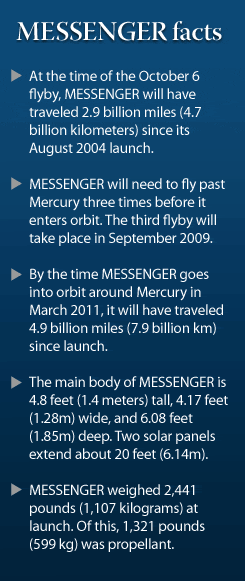
More resources from Astronomy.com:
- Astronomy news
- Astronomy basics
- Glossary of astronomical terms
- Return to Astronomy “For the media” page
News from MESSENGER
Trough on Mercury
(September 24, 2008)
Data from MESSENGER’s first flyby of the planet closest to the Sun have some scientists thinking unique surface structures formed from impacts, others suspect volcanic activity.
Iron ‘snow’ helps maintain Mercury’s magnetic field
(May 8, 2008)
Researchers are closer to understanding how planetary cores evolve.
The Mercury you’ve never seen
(March 11, 2008)
Planetary scientists are starting to make sense out of the 500 megabytes of data returned by the MESSENGER spacecraft during its January 14 flyby of Mercury.
Mercury surprises from MESSENGER
(January 30, 2008)
MESSENGER’s recent flyby of Mercury has provided scientists with an entirely new, and surprising, view of the innermost planet.
MESSENGER at Mercury
(January 28, 2008)
For the first time in more than 30 years, a spacecraft has returned to Mercury, providing images from sections of the planet that have never been viewed by a spacecraft.
Astronomy‘s mission:
Astronomy promotes the science and hobby of astronomy through high-quality publications that engage, inform, entertain, and inspire.
WAUKESHA, Wis. — At 12:31 A.M. EDT October 6, NASA’s MESSENGER spacecraft will skim within 125 miles (200 kilometers) of Mercury’s surface. MESSENGER – short for MErcury Surface, Space ENvironment, GEochemistry, and Ranging – has flown past Mercury once already this year. On January 14, the craft came equally close to the innermost planet, imaging Mercury’s cratered surface and studying its puzzling magnetic field and thin atmosphere.
—-
Astronomy magazine editors are following this mission closely and are available to provide their perspective on this stage of it. To schedule an interview, please contact Matt Quandt at 262.798.6484 or mquandt@kalmbach.com. Also look for mission updates and pictures at Astronomy.com/news.
—-
Yet on October 6, the Sun will be illuminating the hemisphere that lay in darkness back in January. “MESSENGER will view parts of Mercury no one has ever seen up-close before,” says Astronomy magazine Senior Editor Richard Talcott. Not only will the probe observe the opposite half from what it did last time, but it also will reveal some 30 percent of the planet’s surface missed by the Mariner 10 spacecraft in the mid-1970s. This represents the largest area of terra incognita remaining in the solar system.
“MESSENGER’s January flyby revealed unexpected features in the new areas it observed,” Talcott adds. “Now, expectations are running high that more bizarre terrain may show up.”
One surprising feature discovered in January was a spiderlike feature dubbed Pantheon Fossae that sits in the middle of the giant Caloris impact basin. Pantheon Fossae comprises more than 100 narrow, flat-floored troughs that radiate from a complex central structure.
In addition to taking approximately 1,200 images of the planet’s surface, MESSENGER also will explore Mercury’s magnetic field and surrounding magnetic cocoon from a different location and at a different time. This will help scientists determine which features remain constant and which change. Researchers expect similar findings about the planet’s ultrathin atmosphere.
Scientists also will get their first chance to compare Mercury’s topography to high-resolution images. The spacecraft’s laser altimeter measures the height of various terrains. It points in a different direction from the camera, however. During this flyby, the spacecraft will image areas viewed with the altimeter in January, as well as target regions with the altimeter that MESSENGER imaged in January.
The spacecraft’s main objective during this flyby, however, is to steal a little of the planet’s orbital energy. This will set it on a new course that, in 2011, will enable MESSENGER to orbit Mercury. This primary mission is scheduled to last 1 Earth year, during which scientists will get a detailed look at Mercury’s global environment.









